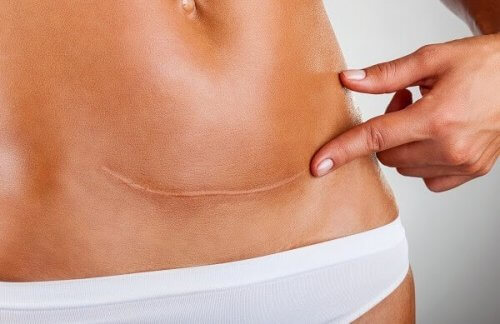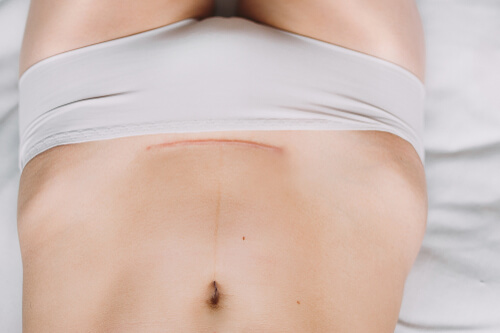Caring for a Cesarean Scar after Childbirth

Caring for a cesarean scar after childbirth is not complicated, but regular aftercare is key to recovery.
As your skin forms scar tissue to heal the wound, it’s important to prevent infection and look out for possible complications.
In this article, we’ll cover some practical tips for caring for a cesarean scar and helping your body heal after childbirth.
How a cesarean scar heals
When a new mom comes out of the operating room, she’ll notice that the area of the incision is covered with a surgical dressing.
Over the first few weeks after a cesarean, she’ll need to pay close attention to this area in case the incision bleeds or opens up.
Women who have had a cesarean will also need to change the dressing regularly to avoid infection.
After a few days, it will no longer be necessary to cover the area of the incision all the time. In general, any wound heals faster when exposed to the open air.
Bandages can seal in moisture, which creates an environment where microorganisms and pathogens can flourish.
Once the scar forms, it will normally be flat and pink in color. However, around 5% of women develop keloid scarring postpartum.
Keloid scars are characterized by abnormal growth of scar tissue, and are more frequent in people with dark skin tones.
With this in mind, women who have given birth by cesarean should have regular check-ups with a trusted healthcare provider.
A medical professional will know how to identify keloid scarring and can offer treatment options to improve the appearance of the scar.

Take care of your skin during pregnancy to aid healing
To make caring for a cesarean scar easier and prevent keloid scarring, begin preparing while you’re still pregnant.
Apply a good moisturizing cream or aloe vera lotion daily to preserve the elasticity of your skin. This will prevent cracking and help the skin scar better after a cesarean.
You can also adjust your diet during pregnancy to give your skin a boost. Pregnant women need to eat plenty of protein and stay well hydrated.
Getting plenty of fruit and vegetables in your diet will also help strengthen your immune system, in addition to preventing constipation.
“Over the first few weeks after a cesarean, a new mother will need to pay close attention in case the incision bleeds or opens up”
Caring for a cesarean scar: daily hygiene
Cleaning the area of the scar daily is crucial to prevent infection. Wash the area with warm water and a mild soap, using very gentle motions.
Stay away from perfumed shower gel, exfoliants and antibacterial soap, all of which may irritate the skin.
After washing and rinsing with plenty of water, make sure to dry the area thoroughly. Damp skin can be a breeding ground for bacteria and other pathogens. Gently pat the area of the incision dry using clean gauze.
As you wash and dry the wound, avoid any sudden movements that strain your abdominal muscles. Any impact or strain to this area may set the healing process back.
“Wash the area with warm water and a mild soap, using very gentle motions”
Leave the scar uncovered to speed up healing
Dressing a wound creates a moist microclimate in the area, which slows the healing process in addition to giving microorganisms an ideal place to breed.
The longer you can leave your cesarean scar exposed to the air, the easier and quicker the healing process will be.
If you need to go out, however, clothes may rub against the area and cause irritation. Use a simple gauze bandage and hypoallergenic medical tape to prevent this.

Look for soft cotton clothing
During the healing process, you’ll be more comfortable in soft, light clothing, preferably made from cotton. Thick clothing and artificial fabrics can trap moisture in the abdominal area, exposing the wound to microorganisms.
If the weather is cold, wear a cotton top as a base layer and then add warmer clothing on top.
The key is to make sure that any fabric that comes into contact with your skin won’t interfere with scarring or cause an allergic reaction.
Every woman is different, and every body heals at a different pace. When caring for a cesarean scar, pay attention to your own needs and listen to your body.
Your first point of contact should be your healthcare practitioner. This professional will give you guidelines for the postpartum period that will help your body recover.
Caring for a cesarean scar after childbirth is not complicated, but regular aftercare is key to recovery.
As your skin forms scar tissue to heal the wound, it’s important to prevent infection and look out for possible complications.
In this article, we’ll cover some practical tips for caring for a cesarean scar and helping your body heal after childbirth.
How a cesarean scar heals
When a new mom comes out of the operating room, she’ll notice that the area of the incision is covered with a surgical dressing.
Over the first few weeks after a cesarean, she’ll need to pay close attention to this area in case the incision bleeds or opens up.
Women who have had a cesarean will also need to change the dressing regularly to avoid infection.
After a few days, it will no longer be necessary to cover the area of the incision all the time. In general, any wound heals faster when exposed to the open air.
Bandages can seal in moisture, which creates an environment where microorganisms and pathogens can flourish.
Once the scar forms, it will normally be flat and pink in color. However, around 5% of women develop keloid scarring postpartum.
Keloid scars are characterized by abnormal growth of scar tissue, and are more frequent in people with dark skin tones.
With this in mind, women who have given birth by cesarean should have regular check-ups with a trusted healthcare provider.
A medical professional will know how to identify keloid scarring and can offer treatment options to improve the appearance of the scar.

Take care of your skin during pregnancy to aid healing
To make caring for a cesarean scar easier and prevent keloid scarring, begin preparing while you’re still pregnant.
Apply a good moisturizing cream or aloe vera lotion daily to preserve the elasticity of your skin. This will prevent cracking and help the skin scar better after a cesarean.
You can also adjust your diet during pregnancy to give your skin a boost. Pregnant women need to eat plenty of protein and stay well hydrated.
Getting plenty of fruit and vegetables in your diet will also help strengthen your immune system, in addition to preventing constipation.
“Over the first few weeks after a cesarean, a new mother will need to pay close attention in case the incision bleeds or opens up”
Caring for a cesarean scar: daily hygiene
Cleaning the area of the scar daily is crucial to prevent infection. Wash the area with warm water and a mild soap, using very gentle motions.
Stay away from perfumed shower gel, exfoliants and antibacterial soap, all of which may irritate the skin.
After washing and rinsing with plenty of water, make sure to dry the area thoroughly. Damp skin can be a breeding ground for bacteria and other pathogens. Gently pat the area of the incision dry using clean gauze.
As you wash and dry the wound, avoid any sudden movements that strain your abdominal muscles. Any impact or strain to this area may set the healing process back.
“Wash the area with warm water and a mild soap, using very gentle motions”
Leave the scar uncovered to speed up healing
Dressing a wound creates a moist microclimate in the area, which slows the healing process in addition to giving microorganisms an ideal place to breed.
The longer you can leave your cesarean scar exposed to the air, the easier and quicker the healing process will be.
If you need to go out, however, clothes may rub against the area and cause irritation. Use a simple gauze bandage and hypoallergenic medical tape to prevent this.

Look for soft cotton clothing
During the healing process, you’ll be more comfortable in soft, light clothing, preferably made from cotton. Thick clothing and artificial fabrics can trap moisture in the abdominal area, exposing the wound to microorganisms.
If the weather is cold, wear a cotton top as a base layer and then add warmer clothing on top.
The key is to make sure that any fabric that comes into contact with your skin won’t interfere with scarring or cause an allergic reaction.
Every woman is different, and every body heals at a different pace. When caring for a cesarean scar, pay attention to your own needs and listen to your body.
Your first point of contact should be your healthcare practitioner. This professional will give you guidelines for the postpartum period that will help your body recover.
All cited sources were thoroughly reviewed by our team to ensure their quality, reliability, currency, and validity. The bibliography of this article was considered reliable and of academic or scientific accuracy.
- American Academy of Dermatology Association. (26 de enero de 2023). Keloid scars: diagnosis and treatment. https://www.aad.org/public/diseases/a-z/keloids-treatment
- American Pregnancy Association. (s. f.). Cesarean After Care. Consultado el día 18 de diciembre de 2023. https://americanpregnancy.org/healthy-pregnancy/labor-and-birth/cesarean-aftercare/
- Kawakita, T., Landy, H. (2017). Surgical site infections after cesarean delivery: epidemiology, prevention and treatment. Maternal Health, Neonatology and Perinatology, 3, 12. https://www.ncbi.nlm.nih.gov/pmc/articles/PMC5497372/
- Lei, Z., Cao, Z., Yang, Z., Ao, M., Jin, W., Yu, L. (2019). Rosehip Oil Promotes Excisional Wound Healing by Accelerating the Phenotypic Transition of Macrophages. Planta Médica, 85(7):563-569. https://pubmed.ncbi.nlm.nih.gov/30199901/
- National Health Services. (4 de enero de 2023). Recovery–Caesarean section. https://www.nhs.uk/conditions/caesarean-section/recovery/
- Wallace, H., Basehore, B., Zito, P. (12 de junio de 2023). Wound Healing Phases. StatPearls. https://www.ncbi.nlm.nih.gov/books/NBK470443/
This text is provided for informational purposes only and does not replace consultation with a professional. If in doubt, consult your specialist.








